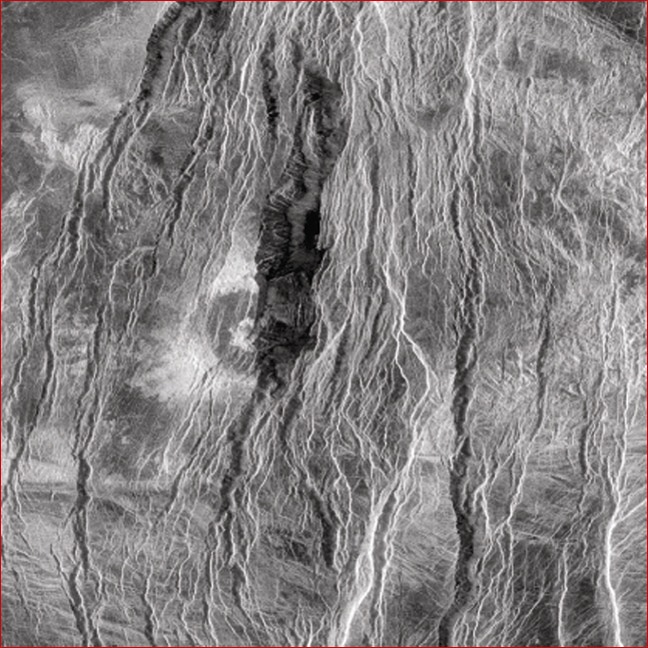
home •
about •
essential guide •
picture of the day •
thunderblogs •
news •
multimedia •
predictions •
products •
get involved •
contact
picture of the day archive subject index
Credit: NASA Magellan Mission
Jan 15, 2008
Venus the Bright Planet
(This TPOD originally appeared on Jul 19, 2007)Venus reflects light from the top of its deep cloud layer, but space probe data indicates that the surface is also highly reflective.
Venus has been the evening star for several months, now. As it begins to move away from its place in twilight skies and take up a position as a familiar dawn companion, the morning star, some interesting facts and puzzling questions about our so-called “sister planet” are worthy of consideration.
The image at the top of the page was sent from Venus by the Magellan spacecraft in September of 1991. Magellan circled Venus in a polar orbit for four years until contact was lost on October 12, 1994. Its primary mission was to use an onboard synthetic aperture radar imaging system and shoot high resolution video of the planet’s strange topography. Balcher crater (center of above image), is approximately 35 kilometers in diameter. It’s unique because the raised central formation, similar to those found in other craters, has been cut in half by some kind of violent tectonic force.
On November 9, 2005, The European Space Agency launched the Venus Express mission from Baikonur Cosmodrome, Kazakhstan. The spacecraft was designed to help answer other intriguing questions about the solar system’s second planet:
1. Why are some areas on the surface so reflective to radar?
2. Is there presently volcanic or seismic activity on the planet?
3. How do the complex global dynamics of the planet work?
4. What causes the super-fast atmospheric rotation and the hurricane-force winds?
5. What maintains the double atmospheric vortex at the poles?Coupled with information collected by the Magellan Mission, the ESA program should provide planetary scientists with enough data to ponder the unusual environment of Venus for years to come. However, because mission scientists are unaware of how the electrical environment of Venus influences the geologic processes and the bizarre terrain that we see, they are not able to provide complete explanations for the complex issues that face them. In past Thunderbolts Pictures of the Day, we have explored some of those issues.
Many of the mountains on Venus have peaks that shine very brightly in radar. Although the reason for the strange brightness is a mystery for NASA, from an electric universe standpoint, the mountain peaks are glowing with a form of “St. Elmo’s Fire.” St. Elmo’s Fire is a plasma phenomenon, similar to static electricity, and charged plasma reflects radar like a mirror. Therefore, the high albedo of the mountains may be the result of that discharge.
Enormous areas of the planet are cut by “nova,” or deep grooves, that extend outward – radially – from an area of parallel fractures. Analysts from NASA and ESA both have identified these formations as the remains of volcanic upwelling. At some time in the past, underground magma partially melted and swelled the surface. After a period of time, the magma subsided, the surface cooled and contracted, leaving behind a network of fractures. As we have noted in the past, however, these features resemble nothing more strongly than lightning scars called, Lichtenberg Figures.
Other complex structures called “coronae” are oval formations that are characterized by rings of ridges and troughs that cut through radial cracks, very much like the striations in the “novae.” Coronae are often found in association with so-called “pancake volcanoes” – wide, flat domes that cover hundreds of square kilometers. Electrical theorists explain such structures, also including “shield volcanoes” and “pedestal craters,” as the result of gigantic plasma discharges. Such electric forces pull material toward the center of the vortex as they carve out craters and channels through the surrounding area. After the electric arc has passed, a raised mound of debris, often with a moat surrounding it, will be left behind. Some of the raised mounds can be very large, such as Olympus Mons on Mars, or the Eistla Region on Venus.
Theories of how Venus was formed and how its surface was blasted and abraded must include the ways that electricity behaves in various circumstances. In the high density atmosphere of Venus, electric arcs will carve out topography similar to that found elsewhere in the solar system, but it will bear unique attributes. For example, highly energetic discharges will leave deeply entrenched formations, as well as swirling structures called, “arachnoids” that bear a resemblance to “spiders” found on Mars, but are far larger and more pronounced. Realizing that all the planets and moons we have explored are probably marked by catastrophic events from a recent past will guide our research toward a more appropriate understanding of why they exhibit such conventionally odd morphology.
By Stephen Smith
__________________________________________________________________________Please visit our new "Thunderblog" page
Through the initiative of managing editor Dave Smith, we’ve begun the launch of a new
page called Thunderblog. Timely presentations of fact and opinion, with emphasis on
new discoveries and the explanatory power of the Electric Universe."The Electric Sky and The Electric Universe available now!

|
|

|
EXECUTIVE EDITORS:
David Talbott, Wallace Thornhill
MANAGING EDITORS:
Steve Smith, Mel Acheson
CONTRIBUTING EDITORS: Michael Armstrong, Dwardu Cardona,
Ev Cochrane,
C.J. Ransom, Don Scott, Rens van der Sluijs, Ian Tresman
WEBMASTER: Brian Talbott
Copyright 2008: thunderbolts.info
![]()
home •
thunderblogs •
forum •
picture of the day •
resources •
team •
updates •
contact us

